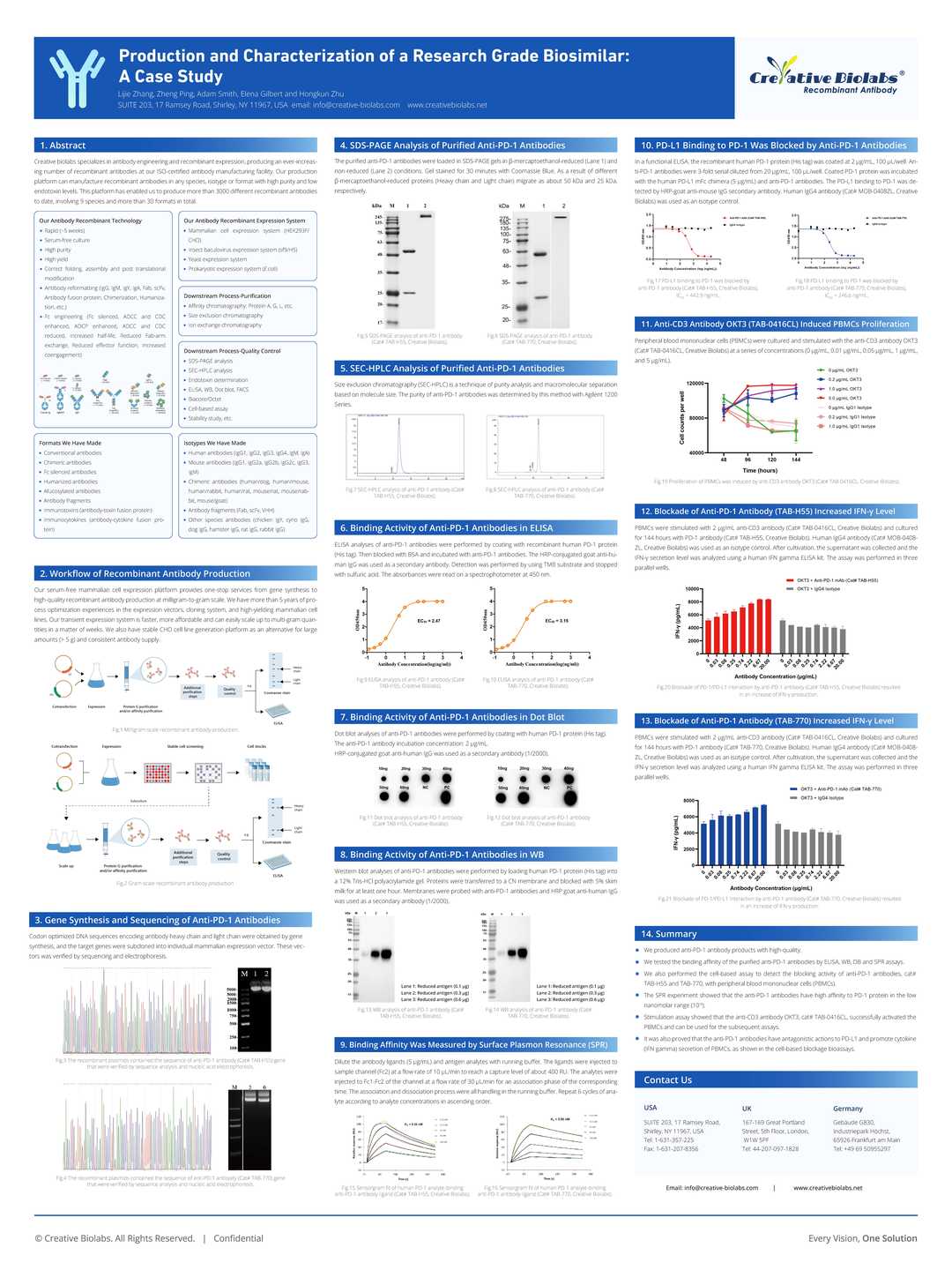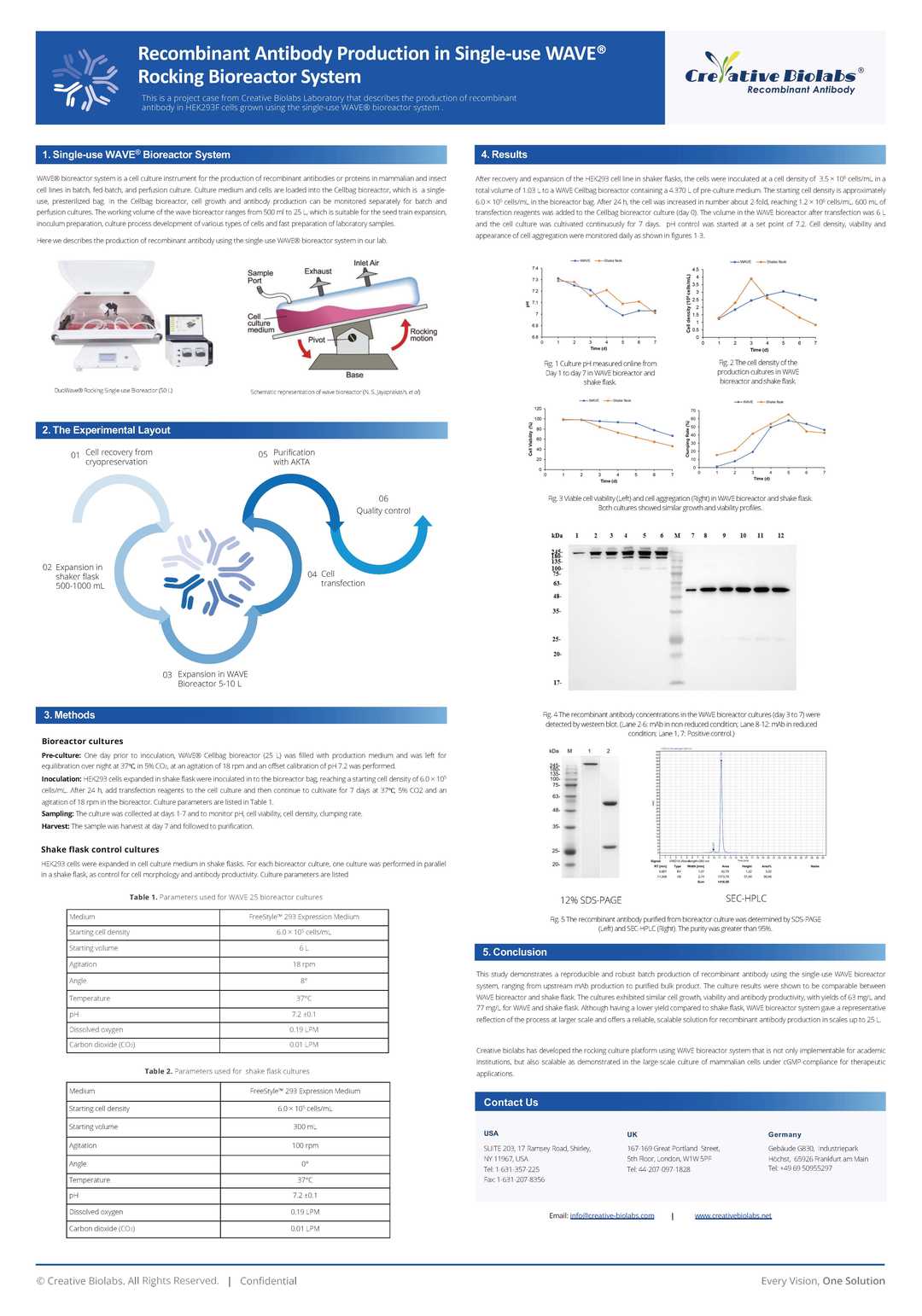Anti-Human DR5 Recombinant Antibody (TAB-180)
CAT#: TAB-180
Recombinant monoclonal antibody to DR5. It is a human monoclonal antibody designed for the treatment of cancers.








Specifications
- Immunogen
- The details of the immunogen for this antibody are not available.
- Host Species
- Human
- Derivation
- Human
- Type
- IgG1 - lambda
- Specificity
- Tested positive against native human antigen.
- Species Reactivity
- Human
- Applications
- FuncS, IF, Neut, ELISA, FC, IP, ICC, WB, Activ, SPR
- MW
- 143.1 kDa
- Related Disease
- Colorectal cancers
Product Property
- Purity
- >97%, by SDS-PAGE under reducing conditions and visualized by silver stain.
- Storage
- Store at -20°C for long-term storage. Store at 2-8°C for up to one month. Avoid freeze/thaw cycles.
Applications
- Application Notes
- The TNFRSF10B antibody has been reported in applications of FuncS, IF, Neut, ELISA, FC, IP, ICC, WB, Activ, SPR.
Target
Customer Review
There are currently no Customer reviews or questions for TAB-180. Click the button above to contact us or submit your feedback about this product.


Q&As
-
What applications is this antibody recommended for?
A: The Anti-DR5 Recombinant Antibody (TAB-180) is recommended for a wide range of applications including Functional Studies, IF, Neutralization, ELISA, FC, IP, ICC, WB, and SPR.
-
Is this antibody suitable for activating the receptor?
A: Yes, this antibody acts as an agonist. It binds to DR5 (TNFRSF10B) and can induce apoptosis signals, mimicking the activity of TRAIL. It is a powerful tool for studying death receptor signaling.
View the frequently asked questions answered by Creative Biolabs Support.
Cite This Product
To accurately reference this product in your publication, please use the following citation information:
(Creative Biolabs Cat# TAB-180, RRID: AB_3111853)
Submit Your Publication
Published with our product? Submit your paper and receive a 10% discount on your next order! Share your research to earn exclusive rewards.
Biosimilar Overview
Please refer to Drozitumab Overview to learn more about the mechanism of action, clinical projects, and approved drugs of Drozitumab.
Downloadable Resources
Download resources about recombinant antibody development and antibody engineering to boost your research.
Product Notes
This is a product of Creative Biolabs' Hi-Affi™ recombinant antibody portfolio, which has several benefits including:
• Increased sensitivity
• Confirmed specificity
• High repeatability
• Excellent batch-to-batch consistency
• Sustainable supply
• Animal-free production
See more details about Hi-Affi™ recombinant antibody benefits.
Datasheet
MSDS
COA
Certificate of Analysis LookupTo download a Certificate of Analysis, please enter a lot number in the search box below. Note: Certificate of Analysis not available for kit components.
Protocol & Troubleshooting
We have outlined the assay protocols, covering reagents, solutions, procedures, and troubleshooting tips for common issues in order to better assist clients in conducting experiments with our products. View the full list of Protocol & Troubleshooting.
See other products for "TNFRSF10B"
Select a product category from the dropdown menu below to view related products.
| CAT | Product Name | Application | Type |
|---|---|---|---|
| MOB-1172z | Mouse Anti-TNFRSF10B Recombinant Antibody (clone 40C9) | FC, ICC, IHC, IP, FuncS | Mouse IgG1 |
| CAT | Product Name | Application | Type |
|---|---|---|---|
| NABL-052 | Recombinant Anti-human TNFRSF10B VHH Single Domain Antibody | WB, ELISA, IHC, FC, FuncS | Llama VHH |
| CAT | Product Name | Application | Type |
|---|---|---|---|
| TAB-203 | Human Anti-TNFRSF10B Recombinant Antibody (TAB-203) | ELISA, IP, FC, FuncS, Neut, IF, ICC | Human IgG1, κ |
| CAT | Product Name | Application | Type |
|---|---|---|---|
| TAB-196 | Anti-Human TRAIL-R2 Recombinant Antibody (TAB-196) | IF, IP, Neut, FuncS, ELISA, FC, ICC | IgG1 |
| CAT | Product Name | Application | Type |
|---|---|---|---|
| TAB-195 | Anti-Human TRAIL-R2 Recombinant Antibody (TAB-195) | ELISA, IP, FC, FuncS, Neut, IF, ICC | IgG1 - lambda |
| CAT | Product Name | Application | Type |
|---|---|---|---|
| TAB-625CL | Human Anti-TNFRSF10B Recombinant Antibody (TAB-625CL) | ELISA | Single Domain Antibody |
| CAT | Product Name | Application | Type |
|---|---|---|---|
| PABL-029 | Human Anti-TNFRSF10B Recombinant Antibody (PABL-029) | WB, ELISA, FuncS | Human IgG |
| CAT | Product Name | Application | Type |
|---|---|---|---|
| PABL-030 | Human Anti-TNFRSF10B Recombinant Antibody (PABL-030) | WB, ELISA, FuncS | Human IgG |
| CAT | Product Name | Application | Type |
|---|---|---|---|
| PSBL-029 | Human Anti-TNFRSF10B Recombinant Antibody; scFv Fragment | WB, ELISA, FuncS | Human scFv |
| CAT | Product Name | Application | Type |
|---|---|---|---|
| PSBL-030 | Human Anti-TNFRSF10B Recombinant Antibody; scFv Fragment (PSBL-030) | WB, ELISA, FuncS | Human scFv |
| CAT | Product Name | Application | Type |
|---|---|---|---|
| PFBL-029 | Human Anti-TNFRSF10B Recombinant Antibody; Fab Fragment | WB, ELISA, FuncS | Human Fab |
| CAT | Product Name | Application | Type |
|---|---|---|---|
| PFBL-030 | Human Anti-TNFRSF10B Recombinant Antibody; Fab Fragment (PFBL-030) | WB, ELISA, FuncS | Human Fab |
| CAT | Product Name | Application | Type |
|---|---|---|---|
| PABW-057 | Human Anti-TNFRSF10B Recombinant Antibody (clone YSd1) | ELISA | Human IgG |
| CAT | Product Name | Application | Type |
|---|---|---|---|
| PABC-123 | Human Anti-TNFRSF10B Recombinant Antibody (clone BDF1) | ELISA | Human IgG |
| CAT | Product Name | Application | Type |
|---|---|---|---|
| PFBW-057 | Human Anti-TNFRSF10B Recombinant Antibody (clone YSd1); Fab Fragment | ELISA | Human Fab |
| CAT | Product Name | Application | Type |
|---|---|---|---|
| PFBC-123 | Human Anti-TNFRSF10B Recombinant Antibody (clone BDF1); Fab Fragment | ELISA | Human Fab |
| CAT | Product Name | Application | Type |
|---|---|---|---|
| PSBW-057 | Human Anti-TNFRSF10B Recombinant Antibody (clone YSd1); scFv Fragment | ELISA | Human scFv |
| CAT | Product Name | Application | Type |
|---|---|---|---|
| PSBC-123 | Human Anti-TNFRSF10B Recombinant Antibody (clone BDF1); scFv Fragment | ELISA | Human scFv |
| CAT | Product Name | Application | Type |
|---|---|---|---|
| TAB-247MZ | Mouse Anti-TNFRSF10B Recombinant Antibody (TAB-247MZ) | ELISA, FC, FuncS, Inhib | Mouse IgG3, κ |
| CAT | Product Name | Application | Type |
|---|---|---|---|
| TAB-248MZ | Mouse Anti-TNFRSF10B Recombinant Antibody (TAB-248MZ) | ELISA, FuncS, Inhib | Mouse IgG |
| CAT | Product Name | Application | Type |
|---|---|---|---|
| TAB-249MZ | Mouse Anti-TNFRSF10B Recombinant Antibody (TAB-249MZ) | ELISA, FuncS, Inhib | Mouse IgG |
| CAT | Product Name | Application | Type |
|---|---|---|---|
| TAB-250MZ | Human Anti-TNFRSF10B Recombinant Antibody (TAB-250MZ) | FuncS | Humanized IgG |
| CAT | Product Name | Application | Type |
|---|---|---|---|
| TAB-251MZ | Human Anti-TNFRSF10B Recombinant Antibody (TAB-251MZ) | FuncS | Humanized IgG |
| CAT | Product Name | Application | Type |
|---|---|---|---|
| TAB-252MZ | Anti-Human TNFRSF10B Recombinant Antibody | ELISA |
| CAT | Product Name | Application | Type |
|---|---|---|---|
| TAB-253MZ | Anti-Human TNFRSF10B Recombinant Antibody (AU11) | ELISA, FuncS | Human antibody |
| CAT | Product Name | Application | Type |
|---|---|---|---|
| TAB-254MZ | Anti-Human TNFRSF10B Recombinant Antibody (AU12) | ELISA, FuncS | Human antibody |
| CAT | Product Name | Application | Type |
|---|---|---|---|
| TAB-247MZ-S(P) | Mouse Anti-TNFRSF10B Recombinant Antibody; scFv Fragment (TAB-247MZ-S(P)) | ELISA, WB | Mouse scFv |
| CAT | Product Name | Application | Type |
|---|---|---|---|
| TAB-250MZ-S(P) | Human Anti-TNFRSF10B Recombinant Antibody; scFv Fragment (TAB-250MZ-S(P)) | FC, ELISA | Humanized scFv |
| CAT | Product Name | Application | Type |
|---|---|---|---|
| TAB-251MZ-S(P) | Human Anti-TNFRSF10B Recombinant Antibody; scFv Fragment (TAB-251MZ-S(P)) | FC, ELISA | Humanized scFv |
| CAT | Product Name | Application | Type |
|---|---|---|---|
| TAB-253MZ-S(P) | Anti-Human TNFRSF10B Recombinant Antibody scFv Fragment (AU11) | FC, ELISA | Human antibody |
| CAT | Product Name | Application | Type |
|---|---|---|---|
| MOR-3604 | Rabbit Anti-TNFRSF10B Recombinant Antibody (clone DS3604AB), PE | FC, WB | Rabbit IgG |
| CAT | Product Name | Application | Type |
|---|---|---|---|
| MOR-3605 | Rabbit Anti-Tnfrsf10b Recombinant Antibody (clone DS3605AB) | ELISA | Rabbit IgG |
| CAT | Product Name | Application | Type |
|---|---|---|---|
| MOR-4468 | Rabbit Anti-Tnfrsf10b Recombinant Antibody (clone SI562DS) | ELISA | Rabbit IgG |
| CAT | Product Name | Application | Type |
|---|---|---|---|
| MOR-4469 | Rabbit Anti-TNFRSF10B Recombinant Antibody (clone SI563DS) | ELISA, FC | Rabbit IgG |
| CAT | Product Name | Application | Type |
|---|---|---|---|
| MOR-4473 | Rabbit Anti-TNFRSF10B Recombinant Antibody (clone SI567DS) | FC | Rabbit IgG |
| CAT | Product Name | Application | Type |
|---|---|---|---|
| MOB-104LC | Human Anti-TNFRSF10B Recombinant Antibody (MOB-104LC) | FuncS | Chimeric (mouse/human) IgG1, κ |
| CAT | Product Name | Application | Type |
|---|---|---|---|
| HPAB-0303-YC-S(P) | Human Anti-TNFRSF10B Recombinant Antibody; scFv Fragment (HPAB-0303-YC-S(P)) | ELISA, FuncS | Human scFv |
| CAT | Product Name | Application | Type |
|---|---|---|---|
| HPAB-0303-YC-F(E) | Human Anti-TNFRSF10B Recombinant Antibody; Fab Fragment (HPAB-0303-YC-F(E)) | ELISA, FuncS | Humanized Fab |
| CAT | Product Name | Application | Type |
|---|---|---|---|
| AFC-TAB-196 | Afuco™ Anti-TNFRSF10B ADCC Recombinant Antibody, ADCC Enhanced (AFC-TAB-196) | IF, IP, Neut, FuncS, ELISA, FC | ADCC enhanced antibody |
| CAT | Product Name | Application | Type |
|---|---|---|---|
| AFC-TAB-203 | Afuco™ Anti-TNFRSF10B Recombinant Antibody (AFC-TAB-203), ADCC Enhanced | ELISA, IP, FC, FuncS, Neut, IF | Human IgG1, κ |
| CAT | Product Name | Application | Type |
|---|---|---|---|
| AFC-TAB-180 | Afuco™ Anti-TNFRSF10B ADCC Recombinant Antibody, ADCC Enhanced (AFC-TAB-180) | FuncS, IF, Neut, ELISA, FC, IP | ADCC enhanced antibody |
| CAT | Product Name | Application | Type |
|---|---|---|---|
| AFC-TAB-195 | Afuco™ Anti-TNFRSF10B ADCC Recombinant Antibody, ADCC Enhanced (AFC-TAB-195) | ELISA, IP, FC, FuncS, Neut, IF | ADCC enhanced antibody |
| CAT | Product Name | Application | Type |
|---|---|---|---|
| HPAB-0703-YJ-VHH | Camelid Anti-TNFRSF10B Recombinant Single Domain Antibody (HPAB-0703-YJ-VHH) | ELISA, Apop | Camelid VHH |
| CAT | Product Name | Application | Type |
|---|---|---|---|
| HPAB-0704-YJ-VHH | Camelid Anti-TNFRSF10B Recombinant Single Domain Antibody (HPAB-0704-YJ-VHH) | ELISA | Camelid VHH |
| CAT | Product Name | Application | Type |
|---|---|---|---|
| VS-0724-XY43 | Mouse Anti-TNFRSF10B Agonistic Antibody (VS-0724-XY43) | Agonistic assays | Mouse IgG1 |
| CAT | Product Name | Application | Type |
|---|---|---|---|
| VS-0724-XY44 | Mouse Anti-TNFRSF10B Agonistic Antibody (clone B-D37) | ELISA, FC, FuncS, IP | Mouse IgG2b, kappa |
| CAT | Product Name | Application | Type |
|---|---|---|---|
| VS-0724-XY60 | Human Anti-TNFRSF10B Agonistic Antibody (clone AMG 655) | ELISA, Agonistic assays | Human IgG |
| CAT | Product Name | Application | Type |
|---|---|---|---|
| VS-0125-FY72 | Human Anti-TNFRSF10B (clone Lexatumumab) scFv-Fc Chimera | ELISA, IP, FC, FuncS, Neut, IF, ADCC | Human IgG1, scFv-Fc |
| CAT | Product Name | Application | Type |
|---|---|---|---|
| VS-0425-YC222 | Recombinant Anti-TNFRSF10B Vesicular Antibody, EV Displayed (VS-0425-YC222) | ELISA, FC, Neut, Cell-uptake |
| CAT | Product Name | Application | Type |
|---|---|---|---|
| VS-0525-XY7361 | Anti-Mouse TNFRSF10B Immunohistochemistry Kit | IHC |
| CAT | Product Name | Application | Type |
|---|---|---|---|
| VS-0525-YC232 | Recombinant Anti-TNFRSF10B (ECD x DD) Biparatopic Antibody, Tandem scFv | ELISA, FC, ICC, IF, IP, Neut | Tandem scFv |
| CAT | Product Name | Application | Type |
|---|---|---|---|
| VS-0525-XY7362 | Anti-Monkey TNFRSF10B Immunohistochemistry Kit | IHC |
| CAT | Product Name | Application | Type |
|---|---|---|---|
| VS-0825-YC334 | SmartAb™ Recombinant Anti-TNFRSF10B pH-dependent Antibody (VS-0825-YC334) | IF, IP, Neut, ELISA, FC, ICC | Human IgG1 |
Popular Products

Application: IF, IP, Neut, FuncS, ELISA, FC, WB

Application: ELISA, IP, FC, FuncS, Neut, IF, IHC

Application: Neut, ELISA, IF, IP, FuncS, FC, IHC

Application: FC, IP, ELISA, Neut, FuncS, IF, WB

Application: FC, IP, ELISA, Neut, FuncS, IF, ICC

Application: Neut, ELISA, FuncS
-CB2006C17L-4.jpg)
Application: WB, ELISA

Application: WB, ELISA, FC, IHC, IP

Application: FC, IHC-Fr, IP, ELISA, Block

Application: Neut, IHC, Activ, FuncS, IF, ELISA

Application: ELISA, IHC, WB

Application: Inhib, FC, WB

Application: ELISA, WB, IF, FC, IP
For research use only. Not intended for any clinical use. No products from Creative Biolabs may be resold, modified for resale or used to manufacture commercial products without prior written approval from Creative Biolabs.
This site is protected by reCAPTCHA and the Google Privacy Policy and Terms of Service apply.





















